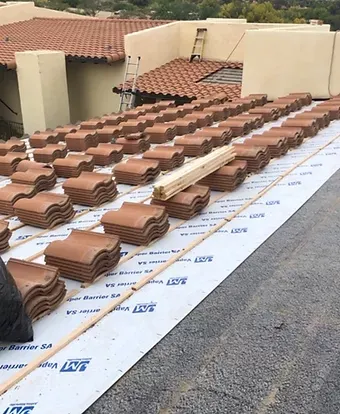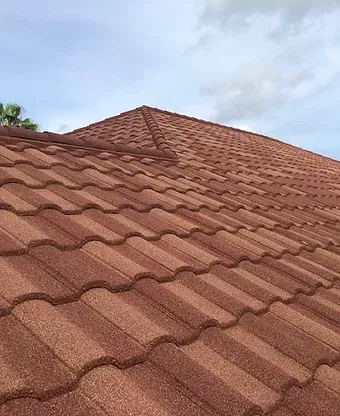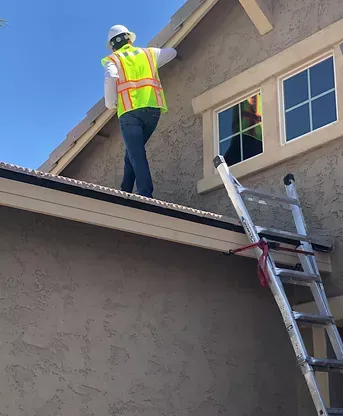A Homeowner's Guide to the Roof Replacement Process in Southwest Florida
A Homeowner's Guide to the Roof Replacement Process in Southwest Florida
Understanding When You Need a Roof Replacement
If you're a homeowner in Southwest Florida, recognizing when it's time for a roof replacement is crucial. Common signs include persistent leaks, missing or damaged shingles, visible sagging, and roofs older than 20 years. The region’s frequent storms and high humidity can accelerate wear and tear, making regular inspections essential. These factors often determine whether your roof needs a full replacement or if repairs will suffice.
In addition to age and visible damage, storm damage plays a significant role in roof longevity. Hurricanes and tropical storms can wreak havoc on roofing materials, leading to costly repairs or replacements. Understanding these triggers helps homeowners make informed decisions about their roofs. With this knowledge, you’ll be better prepared to assess whether your roof needs immediate attention or can last a few more years.
The Initial Roof Inspection and Assessment
A professional roof inspection is the first step in determining whether your roof needs replacement. Inspectors examine the roof’s surface, looking for signs of wear, water damage, and structural issues. In Southwest Florida, inspectors pay special attention to storm-related damage, such as wind uplift or water intrusion, which are common due to the region’s weather patterns.
After the inspection, you’ll receive a detailed estimate outlining the scope of work and costs. This assessment is critical because it ensures that no hidden issues are overlooked before the replacement process begins. A thorough inspection not only identifies current problems but also helps prevent future headaches by addressing potential weak points.
Selecting the Right Roofing Materials for Southwest Florida
Choosing the right roofing material is one of the most important decisions you’ll make during a roof replacement. Asphalt shingles are popular due to their affordability and ease of installation, but they may not always withstand the severe weather conditions in Southwest Florida. Metal roofs, on the other hand, offer excellent hurricane resistance and energy efficiency, though they come with a higher upfront cost.
Tiles, often seen in Mediterranean-style homes , provide a beautiful aesthetic and impressive durability. However, they are heavy and require additional structural support. Each material has pros and cons, particularly in terms of weight, aesthetics, and performance against wind and rain. Homeowners should weigh these factors carefully to select a material that suits both their budget and the local climate.
Energy efficiency is another key consideration for Southwest Florida homeowners. Cool roofs and reflective shingles can help reduce cooling costs by deflecting sunlight. Additionally, some materials are compatible with solar panels, offering long-term savings. By choosing wisely, you can ensure your new roof not only protects your home but also enhances its value and sustainability.
Permit Requirements and HOA Considerations
Before starting a roof replacement, homeowners must navigate the local permit process. Permits ensure that the work complies with Florida building codes, which are designed to protect against hurricanes and other extreme weather events. Required documents typically include plans, specifications, and proof of insurance from your contractor.
Homeowners’ associations (HOAs) can also influence your choices, especially regarding materials and colors. Some HOAs have strict guidelines to maintain neighborhood aesthetics, so it’s important to check their requirements early. Securing necessary approvals from both local authorities and your HOA ensures a smooth replacement process without unexpected delays.
Preparing Your Home for Roof Replacement
Preparation is key to ensuring a hassle-free roof replacement. Start by moving vehicles away from the work area and trimming back any overhanging branches. Protecting landscaping, such as flower beds and shrubs, can prevent damage from falling debris. It’s also wise to notify neighbors about the upcoming project to avoid surprises.
During installation, expect noise, dust, and temporary disruptions. Keep pets and children indoors to ensure their safety. Contractors will take precautions to minimize mess and secure the site, but being proactive about preparation will make the process smoother for everyone involved. Once everything is ready, you can focus on the transformation ahead.
The Roof Removal and Installation Process
The roof replacement process begins with the removal of old materials. Contractors strip away shingles, underlayment, and any damaged sections of the roof deck. This step allows them to inspect the underlying structure for rot or other issues that need repair before proceeding.
Next, a new underlayment is installed as a water barrier to protect against leaks. This layer is critical in Southwest Florida, where heavy rains are common. Afterward, the chosen roofing material is carefully placed, ensuring proper alignment and fastening to withstand strong winds.
Flashing and ventilation systems are added to enhance durability and airflow. Flashing prevents water from seeping into vulnerable areas, while proper ventilation reduces heat buildup in the attic. These features are particularly important in Florida’s humid climate, where excess moisture can lead to mold and structural damage.
Finally, contractors incorporate hurricane-resilient features, such as reinforced fasteners and clips. These additions help secure the roof during storms, providing peace of mind for homeowners. Throughout the process, professionalism and expertise are paramount, ensuring the job is done correctly and efficiently.
What to Expect During Installation Days
On average, a roof replacement takes 2–5 days, depending on factors like size, complexity, and weather conditions. In Southwest Florida, afternoon storms can occasionally delay progress, but experienced contractors plan accordingly to minimize disruptions. Daily activities include removing old materials, installing new layers, and cleaning up debris.
Effective communication with your contractor is essential during this time. They should keep you updated on the timeline and address any concerns promptly. By staying informed, you can ensure the project stays on track and meets your expectations. With proper planning and execution, your new roof will soon be ready to face Florida’s challenging environment.
Inspection and Final Approval
Once the installation is complete, a post-installation inspection ensures the roof meets all standards and codes. Local inspectors look for proper installation techniques, adequate flashing, and compliance with hurricane-resistant features. Passing this inspection confirms that your roof is safe and durable.
Documenting the work and obtaining a certificate of completion is vital for future reference. These records protect your investment, improve resale value, and simplify insurance claims. By ensuring everything is in order, you can enjoy peace of mind knowing your new roof is built to last.
Costs and Financing Options for Roof Replacement
Roof replacement costs in Southwest Florida vary based on factors like material choice, roof size, and complexity. On average, homeowners can expect to pay between $5,000 and $25,000. High-end materials like metal or tile tend to be more expensive but offer greater longevity and energy savings.
Financing options are available to make the investment more manageable. Many contractors offer payment plans, and some government programs provide assistance for energy-efficient upgrades. Homeowners should also check with their insurance providers, as certain policies may cover part of the cost due to storm damage or other covered events.
Energy Efficiency and Roof Features for Southwest Florida Homes
Energy-efficient roofing features are highly beneficial in Southwest Florida’s hot and humid climate. Cool roofs and reflective shingles reduce heat absorption, lowering cooling costs and improving indoor comfort. Improved attic ventilation further enhances energy efficiency by preventing heat buildup.
Additional features like solar panel compatibility and hurricane clips add value and resilience. Solar panels can offset electricity bills, while hurricane clips strengthen the roof’s attachment to the house, reducing the risk of damage during storms. Investing in these features not only benefits your wallet but also contributes to a more sustainable future.
DIY vs. Hiring a Professional Roofing Contractor
While DIY roof replacement is legal in Florida, it comes with significant risks. Permits are still required, and mistakes can lead to costly repairs or voided warranties. Without professional training, it’s easy to overlook critical details that affect safety and durability.
Hiring a licensed contractor ensures compliance with building codes and provides access to manufacturer warranties. Professionals bring expertise, tools, and experience to the table, delivering a high-quality result. For most homeowners, the peace of mind and long-term benefits outweigh the initial cost savings of attempting a DIY project.
Maintenance Tips for Your New Roof
Regular maintenance extends the lifespan of your new roof and keeps it performing optimally. Start by cleaning gutters and downspouts to prevent water backup. Inspect your roof after major storms to identify and address minor issues before they escalate.
Scheduling annual professional inspections is another smart move. Experts can spot potential problems early and recommend timely repairs. By staying proactive, you can maximize your roof’s lifespan and avoid unexpected expenses. A well-maintained roof is your first line of defense against Southwest Florida’s challenging weather.
Frequently Asked Questions
How long does a roof replacement take in Southwest Florida? Most residential roof replacements take 2–5 days, depending on weather, roof size, and material choice.
Do I need a permit for roof replacement in Florida? Yes, a local permit is required, whether the work is done professionally or DIY, and permits must be obtained before starting.
What is the most durable roofing material for hurricanes? Metal roofs and high-quality asphalt shingles are considered most resilient in hurricane zones, but proper installation and extra hurricane clips greatly increase durability.
Can I replace my own roof, or should I hire a pro? While DIY is legal with permits, most homeowners choose licensed contractors for safety, code compliance, and warranty coverage.
Will a new roof increase my home’s value? A new roof improves curb appeal, energy efficiency, and boosts resale value, especially when documented with inspection certificates.
Conclusion
Replacing a roof in Southwest Florida requires careful consideration of climate effects, material choices, and regulatory requirements. From understanding when a replacement is necessary to selecting the right materials and navigating permits, each step plays a vital role in ensuring a successful outcome. Proper preparation and communication with your contractor set the stage for a smooth installation process.
To get started, contact qualified local roofing professionals for a thorough inspection and gather multiple estimates to compare options. Review HOA guidelines and familiarize yourself with local building codes. Investing in a high-quality, climate-resilient roof delivers lasting protection, peace of mind, and enhances property value in Florida’s challenging environment.




